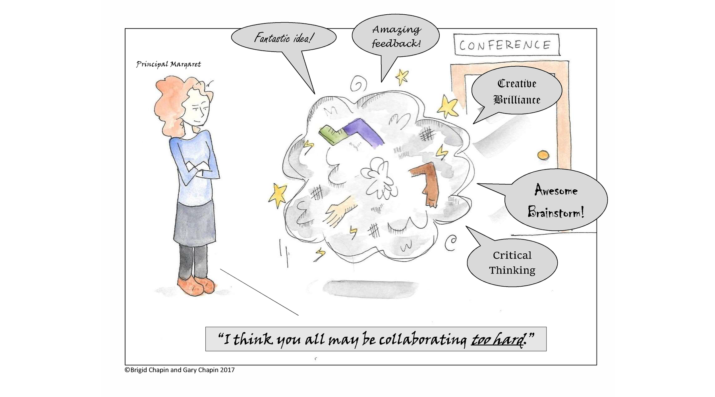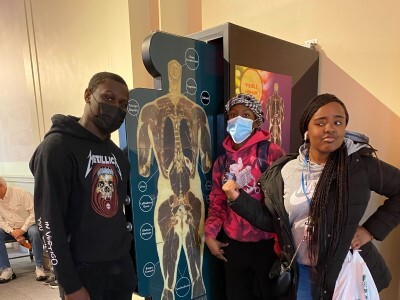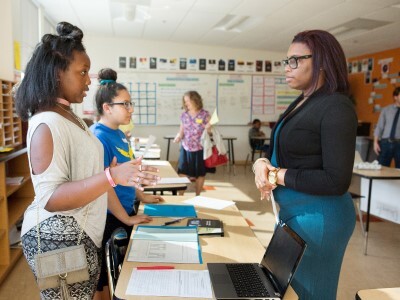Reimagining Assessment
Are We Collaborating Too Much?
Topics

Educators are rethinking the purposes, forms, and nature of assessment. Beyond testing mastery of traditional content knowledge—an essential task, but not nearly sufficient—educators are designing assessment for learning as an integral part of the learning process.
Some things the Center for Collaborative Education learned about collaboration from the Assessment for Learning Project's community of practice.
It is perhaps obvious that the Center for Collaborative Education (CCE) places a premium on collaboration. Examining the Assessment for Learning Project’s (ALP) vision of professional learning and its community of practice, it’s no wonder we, as CCE’s representatives in ALP, felt at home there. Collaboration is at the center of ALP. After the first ALP community of practice convening in Denver in March 2016, Laurie wrote a post for the CCE blog, The Power of Learning Networks. Reflecting on the opportunity to be participating members, rather than our usual role of convener of learning networks, she appreciated “the time to share, reflect, problem-solve, and develop common definitions and language among our peers in the field.”
At that same convening, Gary made a commitment to collaborate with every one of the twelve groups in the room. Bold? Certainly. Reckless? Possibly. Still, as CCE enters into a second phase of our ALP project, the number of connections we’ve made has been notable. Our project focuses on designing and implementing micro-credentials about performance assessment for professional educators (here, we wrote a poem about it). For example, we joined with Del Lago Academy in California to help design STEM badges for students, with the support of local industry. For another, we invited Henry County School in Georgia to the micro-credential pilot, and benefitted from their year of work on abundant and ubiquitous feedback structures. For a third, we joined with Fairfax County Public Schools in Virginia to help them develop capacity in performance assessment design. Finally, as a bonus since they are not an ALP site, we’ve invited Jefferson County Schools in Kentucky to join our pilot. We have spent days at these sites, figuring out how they can learn from us, how we can learn from them, and what we can build together.
At one point, talking to ALP doyen, Tony Siddall, we were going over our collaboration dance card, and Tony said, jokingly, “There should be a cartoon with the caption, ‘You guys are collaborating too much.’” Are we collaborating too much? We are collaborating an awful—excuse me, awesome—lot. (The cartoon above resulted from this quip.)
Here are some things we have learned about collaboration over this year or so of work with the ALP community of practice.
The collaboration is not a means to an end, or a side benefit, or a dividend, or an unintended consequence; it is the power source of the work.
It ain’t easy: Don’t look to collaboration if you’re trying to make your life easier, or simpler, or less stressful, especially in the short-term. For every collaborator—for every new point of contact—you increase the number of possible relationships exponentially! It will be more work and without it we will never achieve equity in education. Collaboration with an intentional focus on cultivating equity and disrupting inequity leads to transparent communication about ideas and strategies. These ideas and strategies in turn lead to new pathways to equity. It is necessary.
It is nonetheless worth your while: If you enter into a collaboration openly and with a willingness to be surprised, you will always get more out of it than you put in (unless you’re talking about time). We have an ambitious mission to affect change; to achieve that mission, we need to get creative on how we are catalyzing change through ALP so that it is greater than the sum of our individual efforts.
You will be surprised at the outcomes and depth: Bringing people together to collaborate is not like stacking bricks or compiling numbers. A collaboration is more than the sum of its participants—the process itself adds value and opens new pathways.
Most often it’s a really good time: The Quality Performance Assessment team at CCE used to have a norm that read, “We strive to have fun while doing good work!” Then we realized that striving may actually preclude fun. Now the norm reads, “We have fun while doing good work.” Among everything else—it is fulfilling, powerful, thrilling—the collaboration within the Assessment for Learning Project has been a good time! We are honored to be a part of it.
There’s a whole lot of collaboration going on! This year, in addition to our original ALP partners in Rhode Island, we are partnering with and will be going to Del Lago Academy, Fairfax County Public Schools, Henry County Schools, and Jefferson County Schools, working with creative educators at every stop, rethinking assessment, and re-creating it. The collaboration is not a means to an end, or a side benefit, or a dividend, or an unintended consequence; it is the power source of the work. How we do our work matters to the “what” and the “why” of our mission. In short, the answer to our question is, “No, we are not collaborating too much.”




